DeMars Guitars founder gives the low-down on his instruments, customer base (including Phil Lesh) and why his basses outsell his guitars 4-to-1!
Exclusive interview with FBPO’s Jon Liebman
October 4, 2010
A guitarist and bassist for over three decades, Dan DeMars has designed guitars for over twenty years and has worked with legendary instrument designer Ned Steinberger, who reminded him that there are no hard-and-fast rules in design and guitar making. For several years, Dan headed the marketing, advertising/promotion and artist relations functions for Ned’s concert string instrument company, NS Design.
While working with Ned, Dan established Musica Viridis, a consulting firm that facilitated the marketing operations of small-to-midsize makers of musical instruments. In this capacity, he continues to consult with several guitar companies.
Ned’s influence, along with the business potential evident at NAMM, encouraged Dan to develop DeMars Guitars into a viable commercial enterprise. In addition to being a guitar designer and builder, Dan holds an MBA from a “Top 10” business school and brings a wealth of business management experience to the musical instrument industry. Dan and his family reside in Norwich, Vermont.
FBPO: Tell me about your musical upbringing.
DD: Well, I’ve been playing guitar and piano since around age 10 and picked up other instruments like bass, mandolin, banjo and ukulele in my twenties. There was always a guitar around the house when I was growing up, as my dad plays. He’s 83 now and still plays his Gibson ES every day! Good product design has always attracted me, whether it’s guitars, cars, appliances … whatever. I remember sketching guitars in the margins of my notebooks during high school and college. When Ned Steinberger introduced the headless bass back in the late 1970s, I instantly thought, “This guy gets it!” It was the perfect marriage of form and function – elegant yet minimalist, innovative yet not too “out there.” He proved that electric guitar bodies do not have to be big, since they don’t move air in the manner of acoustic instruments. They can be any size, shape or material the designer chooses.
FBPO: How did you make the transition from player to manufacturer?
DD: I really don’t consider myself a player. I mean I can play guitar and bass, but I never had any aspirations about pursuing music or being a performer. For me, playing music was simply about enjoying it. Around 1984, I built my first electric guitar, using a neck from an old Teisco guitar neck bolted onto a 2×12 pine body of original design. In fact, I still have that guitar. The shape is an amalgam of an SG, a BC Rich and a Hofner violin bass, if you can believe that. Granted, this was 1984, so it had three DiMarzio pickups – a PAF at the neck, a coil-splittable Dual in the middle and a Super Distortion at the bridge – and a BadAss combo bridge/tailpiece. The amazing thing about this instrument is that it still plays and sounds good, although the intonation is far from perfect. Still, not bad for a first try.

DeMars 5-string bass
FBPO: How did you hook up with Ned Steinberger?
DD: I had been building instruments over the years, purely as a hobby, and in 1994 my wife and I received a Christmas card from one of her best friends who reported that she was “engaged to an industrial designer named Ned Steinberger.” Ned and I met a couple years later and became friends, sharing thoughts and ideas on instrument design. This was around the same time that NS Design, his electric concert string instrument company, was getting started.
Ned called me one day to see if I’d be interested in helping him out on the business end of NS Design – stuff like the design of their promotional literature and website, managing the NAMM booth, contacting the media, handling artist relations, training his shop staff on working a booth and dealing with customers, etc. I kept Ned at arm’s length for a few months while I was starting my own biotech consulting company, but soon realized that I could in fact do the work remotely on my own time. Ned and I agreed that I’d give him one day a week, and the rest is history. After about three years, we realized that my mission was accomplished: NS Design is firmly established in the world of electric concert string instruments and I’m very proud that I had something to do with it.
FBPO: It sounds like you may have been bitten by the “instrument-making” bug.
DD: I guess you could say that. During the time I was working with Ned, I began exploring my own ideas about chambered solid-bodied instruments. Ned and a few of his associates within the industry – Hap Kuffner, for one – were very encouraging about the pursuit of my interests. Via the NAMM shows, I learned a ton about the industry. I was also able to use my MBA skills to look at the business process and the gained a lot of experience in dealing with suppliers, vendors, OEMs, distributors, dealers, media and artist relationships, all in a formal manner, rather than just being thrown into it.
FBPO: How would you describe the products you make at DeMars Guitars?
DD: We’re a “boutique” builder, but I am careful to say that we’re not a custom builder, a term in this industry that has very specific meaning. Our instruments are all made in the U.S., using precision CAD/CAM manufacturing methods. We use only the finest materials and components and try to source everything from the U.S., although exotic woods like rosewood and ebony are obviously sourced elsewhere. We also offer an outboard three-band EQ and direct box, the XLQ, which is essentially our version of a similar unit from our piezo and preamp supplier, K&K Electronics. The XLQ allows convenient outboard tonal control for the Viridis and Long Trail basses, along with parallel ¼” and XLR outputs.
FBPO: How do your guitars and basses differ from those made by other manufacturers?
DD: We offer two distinct lines of instruments: piezo-equipped chambered solid-body acoustic/electric instruments (the Viridis Guitar and Long Trail Bass) and magnetic pickup-equipped chambered solid-body electric instruments (the Long Trail Mag Bass and the Equinox Guitar). Traditional acoustic guitars and basses are typically 4” thick, with sharp right angle edges that dig into your ribs and strumming arm. The DeMars Guitars acoustic/electric instruments are only 2” thick, with a ribcage contour that allows the instrument to fit snugly against your body. It’s as comfortable to hold and wear as your favorite electric.
The Long Trail Bass and Viridis Guitar also employ a unique patent-pending dual-piezo design, which, in addition to the traditional under-saddle transducer, employs a piezo transducer situated under the neck heel, thus capturing the influence of the neck on the instrument’s overall tone. As proof, we were fortunate to be approached by the Bose Corporation, who recognized the tonal superiority of our instruments. DeMars Guitars is one of only about a dozen companies for whom Bose has developed tonal presets for their revolutionary L1 sound system.
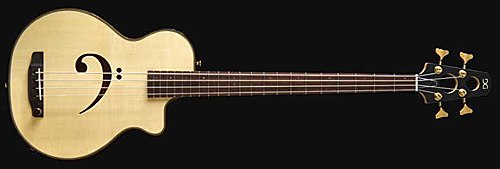
DeMars 4-string bass
FBPO: Do you have any models that stand out as special to you?
DD: As a guitarist primarily, the Viridis is an instrument I really like, especially since these solve the critical design flaws inherent in traditional hollow-bodied acoustic guitars. Since the guitar market is seven times the size of the bass market, I had every confidence that the Viridis guitar would outsell the Long Trail bass commensurately. I was surprised, in a good way, by how much the bass clef sound hole on the Long Trail resonated with bass players. Once they plugged in and played, the sound and tonal depth blew them away! As a result, our basses outsell our guitars by about 4:1. Our fretless 5-string Long Trail bass, with its 35” scale, has convinced several players to retire their traditional acoustic upright basses.
FBPO: Can you name a few high-profile musicians who use your products?
DD: Phil Lesh of the Grateful Dead is probably our best known. He had seen the Long Trail bass featured in Bass Player magazine and The Robb Report. He was looking for a comfortable thin-bodied acoustic bass guitar to play live and called me out of the blue to learn about one. By the end of the conversation, he asked me to ship a brand new fretted 5-string Long Trail overnight, as he was about to play the Bonnaroo festival the following week. Other players include Derrick Murdock, the bassist on NBC’s The Tonight Show, and a few other players who are not as well known, but who have given our instruments some wonderful exposure. It’s important to note that we do not give away any instruments to players in return for endorsements. Since there is little motivation to play an instrument that’s given to you, we have all players pay for their instruments.

Dan DeMars, left, with the Grateful Dead’s Phil Lesh
FBPO: What are your plans for the future of DeMars Guitars?
DD: We plan to grow organically and intelligently. It would be great for our line to be placed in fifty or so of the “right” higher-end dealers in the U.S. and Canada. International distribution can wait, although I have sold a number to instruments directly to players overseas. I have been approached by several Asian companies to outsource manufacturing there and produce lower-cost instruments. At this point I have no plans to do so, but it is worthy of considering.
FBPO: What do you like to do that’s not necessarily musically-oriented?
DD: My wife works long hours and we have two school-aged sons, so family life keeps me busy. Living in Vermont, we’re big hockey fans and we ski a lot during the winter. In the summer, my sons and I go on a couple camping trips. I am also active as a volunteer at our local science museum and I serve on the board of trustees at my older son’s boarding school. All in all, a busy and enjoyable journey!
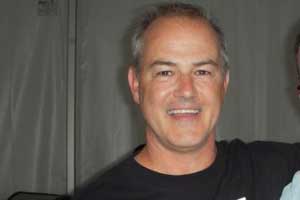

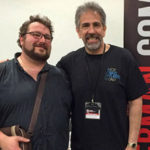
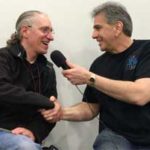
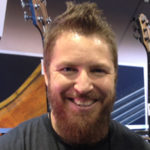

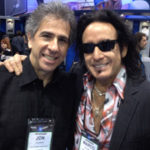
Does Demars still produce the “Long Trail” bass?